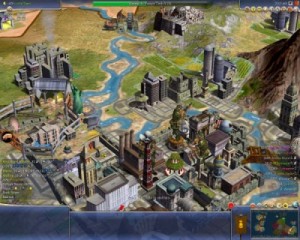Posts tagged constructivism
A Quality Learning Experience
1Halfway through my first semester of the EDTECH program at Boise State, I realized that I was going to have a high-quality online learning experience, because online teaching is a chunk of what the program is about. The professors practice what they preach. The two ingredients for me that have made the program a success so far are the engagement and the project-based learning.
My first memories of online courses date back to about 2001, when my undergraduate school was first implementing online learning. It was a prime example of what not to do: no collaboration, faulty assessment tools, and no interaction with the teacher. There were few, if any opportunities to interact with the other students online. The assessments were basically just the same quizzes used in the brick-and-mortar version of the class, but with a time limit slapped on and the ability to “cheat” by reading your textbook. And the teacher was unavailable, and wouldn’t respond to emails for three or four days at a time.
Contrast that with the highly constructivist, collaborative, project-based learning model Boise State’s EDTECH program has adopted in its classes. It is an engaging experience. I’m finding that I’m learning and retaining more knowledge than I have before. The collaboration is invaluable as I develop and refine my projects, not to mention the enjoyment that comes from sharing one’s hard work with peers. Being able to create projects that I can directly use in my own line of work is motivation to finish them and do my best. For me, at least, I consider that an indication of this instructional model’s efficacy.
In our school district’s summer technology conference, all learning follows a similar hands-on learning model. Participants are expected to create content, rather than simply learn about it. There is still an approach where the instructor is more a lecturer than a facilitator, but every participant sits at a computer, learns about the technology tools, and constructively uses them during the instruction.
Related articles
- Project-Based Learning (taraprogram2011.wordpress.com)
- Student Perspectives on eLearning: Not Just an Education but a Way of Life (einsights.typepad.com)

Reflections on Constructivism
1 Technology-based learning has changed rapidly in the last several years. In the 21st century, Internet access has penetrated every major city, and brought degrees of collaboration and communication that 20 years ago would have been impossible. Our civilization has been transformed into a networked world.
Technology-based learning has changed rapidly in the last several years. In the 21st century, Internet access has penetrated every major city, and brought degrees of collaboration and communication that 20 years ago would have been impossible. Our civilization has been transformed into a networked world.
During this time, when technology is growing by leaps and bounds, it’s increasingly apparent that we need a good approach to use our modern technology tools for learning, and harness their educational potential. Constructivism seems to be particularly suited for computer-based learning.
Technology teaching is well served by adopting a constructivist approach. A lot of the activities taught in technology classes are hands-on with guided instruction. The students are required to actually delve into the technology tools and actively use them by creating 3d character models, writing programs, designing graphics, and so on. Students only learn so much by watching someone build a character in Maya or code a simple game in Visual Basic, and learn much more by actually going through the steps themselves.
If the end goal is for a student to do something, then it’s not very productive to make them simply observe. If I’m training a teacher to use their new blog, I don’t want them make them sit and watch me do all the work. I want them to actually dive right into their blog’s dashboard and start using it, and help them make the mental connections to figure out how they can use it in their own classroom. Recognizing that their professional experience is different than mine, I want them to be able to construct what they learn in relation to their own experience. (And at the very least, they’ll have created some original content at the end of the instruction, and made some progress in getting their blog underway).
When I assisted with the founding of Venture Academy, a charter school in my area, I attended a lot of meetings about the expeditionary learning approach the school espouses. I have very positive feelings about expeditionary learning, but I didn’t realize at the time I was favoring a highly-constructivist style of learning. At Venture Academy, most of the learning is hands-on, with the teacher guiding and providing direction, rather than standing at the front of the classroom lecturing. Field trips, or “expeditions” as they’re called, are frequent, as the philosophy is that students learn best by experiencing the subject matter in a real-world context. Students are responsible for collecting their own data and finding ways to relate to what they’re learning during these expeditions. In the classroom, students are always working in collaborative groups — the desks are never arranged in rows, but in clusters to encourage communication. Children host their own parent-teacher conferences, with the teacher acting as a facilitator and prompting the students to share what they’ve learned in class, and where they could improve. The reflection on what has been learned is another key process in the constructivist approach.
 There are those who claim the effectiveness of constructivism is lacking. For example, Kirschner, Sweller, & Clark (2006) claim that the evidence “almost uniformly supports direct, strong instructional guidance rather than constructivist-based minimal guidance during the instruction of novice to intermediate learners” (p. 83). I will agree that in many instances students learn best when the teacher has a strong presence as a guide, but I don’t think constructivism necessarily excludes strong guidance. If anything, constructivism encourages an intense commitment from the instructor. They must constantly evaluate and revise the learning environment to make sure the students’ learning is always relevant.
There are those who claim the effectiveness of constructivism is lacking. For example, Kirschner, Sweller, & Clark (2006) claim that the evidence “almost uniformly supports direct, strong instructional guidance rather than constructivist-based minimal guidance during the instruction of novice to intermediate learners” (p. 83). I will agree that in many instances students learn best when the teacher has a strong presence as a guide, but I don’t think constructivism necessarily excludes strong guidance. If anything, constructivism encourages an intense commitment from the instructor. They must constantly evaluate and revise the learning environment to make sure the students’ learning is always relevant.
There’s a lot more to constructivism than simply letting students “do all the work.” Nanjappa & Grant (2003) note that as a “facilitator of learning, the teacher is not ineffectual and on the sidelines. On the contrary, the teacher is free to use a variety of constructivist strategies, such as coaching, modeling, and scaffolding, to aid each learner” (p. 49). A facilitator is a support person, someone who stimulates and encourages the cognitive growth of the learner. The teacher must know how to create a learning environment in which students can actively practice and reflect on what they are learning, rather than merely listening to instruction being delivered.
References
Kirschner, P. A., Sweller, J., & Clark, R. E. (2006). Why minimal guidance during instruction does not work: An analysis of the failure of constructivist, discovery, problem-based, experiential, and inquiry-based teaching. Educational Psychologist, 41(2), 75-86.
Nanjappa, A., & Grant, M. M. (2003). Constructing on constructivism: The role of technology. Electronic Journal for the Integration of Technology in Education, 2(1), 38-56.
 Gaming is an activity enjoyed by many students, and when used for educational purposes, games can improve student motivation towards learning, particularly when used in the creation of constructivist learning opportunities. Applying constructivist principles to educational game-based learning activities yields an approach that puts students in the role of active learners and content creators.
Gaming is an activity enjoyed by many students, and when used for educational purposes, games can improve student motivation towards learning, particularly when used in the creation of constructivist learning opportunities. Applying constructivist principles to educational game-based learning activities yields an approach that puts students in the role of active learners and content creators.